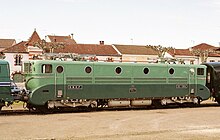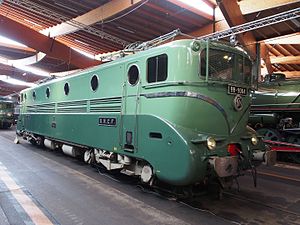SNCF BB 9003 and 9004
| SNCF BB 9003 and 9004 | |
|---|---|
|
BB 9004
|
|
| Numbering: | BB 9003 BB 9004 |
| Number: | 2 |
| Manufacturer: | Jeumont-Schneider , Oerlikon |
| Year of construction (s): | BB 9003: 1952 BB 9004: 1954 |
| Retirement: | 1973 |
| Axis formula : | Bo'Bo ' |
| Gauge : | 1435 mm ( standard gauge ) |
| Length over buffers: | 16,200 mm |
| Length: | 15,010 mm |
| Height: | 3,650 mm |
| Width: | 2,980 mm |
| Trunnion Distance: | 9,200 |
| Bogie axle base: | 3,200 mm |
| Total wheelbase: | 12,400 mm |
| Service mass: | BB 9003: 80 t BB 9004: 83 t |
| Friction mass: | BB 9003: 80 t BB 9004: 83 t |
| Wheel set mass : | BB 9003: 20 t BB 9004: 21 t |
| Top speed: | 140 km / h |
| Hourly output : | 3,400 kW |
| Continuous output : | 3,180 kW |
| Driving wheel diameter: | 1,300 mm |
| Power system : | 1.5 kV direct current |
| Power transmission: | Overhead line 2 pantographs (type; G) |
| Number of traction motors: | 4th |
| Drive: | Hollow shaft drive |
The SNCF BB 9003 and 9004 were French electric locomotives from 1952 and 1954, which were intended as test locomotives for the construction of a larger series of four-axle locomotives in bogie construction . Both locomotives were built at the same time as the BB 9001 and 9002 , but in contrast to these, they were manufactured by French companies. The BB 9004 set the world record on rails at a speed of 331 km / h in 1955 and is now an exhibit in the Mulhouse Railway Museum .
history
After 1945, the French state railway, SNCF, followed the trend emanating from the Swiss Federal Railways and manufactured electric locomotives without running axles with bogies. In contrast to the six-axle SNCF CC 7100 , which had a calmer position on the track, but showed wear when cornering, lighter machines with the B'B ' wheel arrangement were to be created for express train service . Of these, four prototypes were also built in 1953 for a later larger series.
While the BB 9001 and 9002 were made at SLM Winterthur , the BB 9003 and BB 9004 were manufactured by Jeumont-Schneider and only received accessories from the Oerlikon machine factory . In addition to the round body shape, the locomotives had a partial cladding in the lower part of the front area and numerous decorative strips. Technically, a cardan drive was used for the first time , the bogies are welded constructions by André Jacquemin .
Extensive test drives were carried out with these four locomotives, with both French locomotives carrying out some innovative tests of international standing in 1955. While the BB 9003 was the first locomotive in the world on 31 March 1955 on the route from Paris to Dijon with remote control wrong, who came BB 9004 the honor of the world record runs SNCF on 28/29. March 1955 together with the CC 7107.
World record run from 1955
In order to gain knowledge of the speed limits and a comparison of the two undercarriage designs of bogies without running axles and the power transmission to the locomotives, the world record runs were carried out in 1955, which the BB 9004 finally completed successfully on March 29, 1955 with a top speed of 331 km / h were. Although the record runs were prepared intensively for almost a year, valuable knowledge was gained in railway operations for the limits of what is feasible.
The BB 9003 took part in the preparations . Tested by numerous running tests on the test bench, the result for the BB 9004 was a drive with a transmission ratio of 0.849, which was designed for a speed of over 400 km / h. The existing spoked wheels of the BB 9004 were exchanged for monobloc wheels with a wheel thickness of 140 mm, which were designed for the same diameter of turbine wheels with a peripheral speed of 100 m / s. Particular emphasis was placed on the power transmission of 4,000 A for the pantographs and the return of current via the wheels of 1,000 A for the traction motors, among other things, the traction motors were given carbon brushes of much higher quality than for normal operation. The pantographs were designed with a special design with four contact strips for a larger scraping width, all moving parts of the pantographs were monitored by measuring transmitters in order to be able to trace any movements of the contact line on the locomotive while it was in motion.
The fastening of the pantographs was tested in the wind tunnel . The lowering time of the pantograph has been changed from twelve to one second and the time to start the pantograph from ten to six seconds in order to be able to react better to disturbances. It was only allowed to drive with a pantograph attached. To avoid flying sparks during the return line over the rails, a mobile connection line was installed between the wheels of the locomotive and the wagons. The transmission from the axle bearings took place via sliding contacts. Last but not least, emphasis was placed on improving the aerodynamics through special enclosures between the locomotive and the car.
Despite these intensive preparations, there was still a residual risk of driving at the high speeds. So were z. For example, the movements of the contact line at temperatures above 20 ° C were so great that journeys were only allowed at low temperatures and the contact line had to be constantly monitored. The flying sparks at the pantograph were nevertheless enormous, and the BB 9004 could only reach 331 km / h because after the contact strips of one pantograph had melted, it still had the second pantograph available with the short connection time. When the four-axle locomotive was braked, it lurched so badly that some track sections were severely warped .
Whereabouts

The knowledge gained from the prototype locomotives led to valuable experience in the design and manufacture of the BB 9200 , BB 16000 , BB 20100 and many others. The BB 9003/9004 were still used in demand train service for a few years. In 1973 they were retired. Since the locomotive body of the world record locomotive was damaged, it was rebuilt with parts of the BB 9003 and is now located next to the CC 7107 in the Mulhouse Railway Museum.
literature
- Dieter Bäzold: 100 years of electric locomotives , in: Der Modelleisenbahner 6/1979, page 158
Web links
- detailed film about the world record run by the SNCF in 1955
- Website about the world record test drives 1955 (French)
- Website about a short outline of the BB 9004 (French)
- Website about the technology of the BB 9004 (French)
- Website about the history of the BB 9004 (French)
Individual evidence
- ↑ a b c d website about the history of the BB 9004
- ↑ Internet page about the technology of the BB 9004
- ↑ a b c film about the world record run from 1955 on youtube
- ↑ Sketch of the drive of the BB 9004 original and for the world record run
- ↑ a b c d Internet site about the record runs of the SNCF in 1955
- ↑ Principle sketch of the pantographs of the world record locomotives
- ↑ Principle sketch of the measurement monitoring of the moving parts of the pantograph
- ↑ Photo about wind tunnel tests with the pantographs of the BB 9004
- ↑ Principle sketch of the current return during the world record attempts
- ↑ Construction of the sliding contacts for the power return during the world record runs
- ↑ Photos of the wrapping of the vehicles
- ↑ Report on the track warping during the record runs of the SNCF, Figure 1


